 [Update 4/28/2008: Let me spoil the fun by pointing out that this post was supposed to be a joke. Apologies, for being excessively indirect again, to the half-a-dozen commenters who have earnestly informed me that English-language puzzles limit themselves to our standard 26 letters. I was just trying to underline, jocularly, Roger Shuy's jocular point that analogous limiting conventions in texting will probably not destroy … Oh, never mind.]
[Update 4/28/2008: Let me spoil the fun by pointing out that this post was supposed to be a joke. Apologies, for being excessively indirect again, to the half-a-dozen commenters who have earnestly informed me that English-language puzzles limit themselves to our standard 26 letters. I was just trying to underline, jocularly, Roger Shuy's jocular point that analogous limiting conventions in texting will probably not destroy … Oh, never mind.]
In a recent post, Roger Shuy warned us about the threat to civilization posed by the New York Times crossword puzzle:
Correct answers to the Times puzzles require no apostrophes to mark the important distinction between “its” from “it’s” or even to indicate possessive nouns. No correctly hyphenated words are permitted. And even though you know better, have you ever been able to use a comma, colon, semicolon, quotation mark, virgule, or question mark in a New York Times crossword puzzle? No, you haven’t! Not even periods after abbreviations. No spaces between words in phrases. No dashes in front of suffixes. How’s that for creeping whateverism?
As Roger observed, it's striking that those who urge action against the barbarian hordes of txters are unconcerned about the fifth column of crossworders in our midst. But Joe Gordon is sounding the tocsin. A long-time Language Log correspondent, Joe has sent me a series of notes on this subject, focusing especially on the New York Times crossword for Thursday, April 24, in which the clue to 28 across was "Mayo can be found in it", and the required answer is A-N-O. As Joe explains:
This is wrong … N is not the same letter as the one that appears in the word Year translated into Spanish. It is a different letter. I swear. Look it up.
Given the error, the clue reads, translated, "Mayo can be found in it", answer, "Anus".
Read the rest of this entry »


